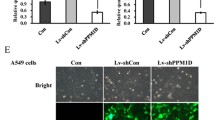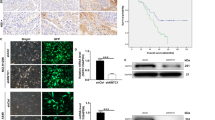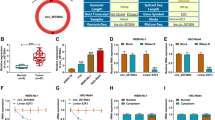Abstract
ZNF403, also known as GGNBP2 (gametogenetin binding protein 2), is a highly conserved gene implicated in spermatogenesis. However, the exact biological function of ZNF403 is not clear. In this study, we identified the role of ZNF403 in cell proliferation and cell-cycle regulation by utilizing short hairpin RNA (shRNA)-mediated knockdown. ZNF403-specific shRNA expressing helper-dependent adenoviral vector (HD-Ad-ZNF403-shRNA) was constructed and transduced human cell lines. ZNF403 mRNA and protein expression levels were inhibited as evidenced by real-time PCR and western blot analyses. Noticeably, we found that knockdown of ZNF403 expression suppressed cell proliferation compared to the non-target shRNA and vector controls. Furthermore, cell-cycle analysis demonstrated that downregulation of ZNF403 promoted G2/M cell-cycle arrest in a dose-dependent manner. Moreover, human cell-cycle real-time PCR array revealed that ZNF403 knockdown influenced the expression profile of genes in cell-cycle regulation. Among these genes, western blot analysis confirmed the protein up-regulation of p21 and down-regulation of MCM2 in response to the ZNF403 knockdown. Additionally, knockdown of ZNF403 also showed an anti-carcinogenetic effect on anchorage-independent growth by colony formation assay and tumor cell migration by wound-healing assay with human laryngeal cancer cell line Hep-2 cells. Altogether, our findings suggest an essential role of ZNF403 in cell proliferation and provide a new insight into the function of ZNF403 in regulating the G2/M cell-cycle transition.






Similar content being viewed by others
References
Plummer SJ, Paris MJ, Myles J, Tubbs R, Crowe J, Casey G (1997) Four regions of allelic imbalance on 17q12-qter associated with high-grade breast tumors. Genes Chromosomes Cancer 20(4):354–362. doi:10.1002/(SICI)1098-2264(199712)20:4<354:AID-GCC6>3.0.CO;2-0
Li Y, Chen Z (2004) Molecular cloning and characterization of LCRG1 a novel gene localized to the tumor suppressor locus D17S800-D17S930. Cancer Lett 209(1):75–85. doi:10.1016/j.canlet.2003.11.034
Li YJ, Xie HL, Chen ZC, He CM (2001) Cloning and expression analysis of a laryngeal carcinoma related gene, LCRG1. Sheng Wu Hua Xue Yu Sheng Wu Wu Li Xue Bao (Shanghai) 33(3):315–319
Cuddihy AR, O’Connell MJ (2003) Cell-cycle responses to DNA damage in G2. Int Rev Cytol 222:99–140
Ohbayashi T, Oikawa K, Iwata R, Kameta A, Evine K, Isobe T, Matsuda Y, Mimura J, Fujii-Kuriyama Y, Kuroda M, Mukai K (2001) Dioxin induces a novel nuclear factor, DIF-3, that is implicated in spermatogenesis. FEBS Lett 508(3):341–344
Zhang J, Wang Y, Zhou Y, Cao Z, Huang P, Lu B (2005) Yeast two-hybrid screens imply that GGNBP1, GGNBP2 and OAZ3 are potential interaction partners of testicular germ cell-specific protein GGN1. FEBS Lett 579(2):559–566. doi:10.1016/j.febslet.2004.10.112
Jamsai D, Bianco DM, Smith SJ, Merriner DJ, Ly-Huynh JD, Herlihy A, Niranjan B, Gibbs GM, O’Bryan MK (2008) Characterization of gametogenetin 1 (GGN1) and its potential role in male fertility through the interaction with the ion channel regulator, cysteine-rich secretory protein 2 (CRISP2) in the sperm tail. Reproduction 135(6):751–759. doi:10.1530/REP-07-0485
Lu B, Bishop CE (2003) Mouse GGN1 and GGN3, two germ cell-specific proteins from the single gene Ggn, interact with mouse POG and play a role in spermatogenesis. J Biol Chem 278(18):16289–16296. doi:10.1074/jbc.M211023200
Puntervoll P, Linding R, Gemund C, Chabanis-Davidson S, Mattingsdal M, Cameron S, Martin DM, Ausiello G, Brannetti B, Costantini A, Ferre F, Maselli V, Via A, Cesareni G, Diella F, Superti-Furga G, Wyrwicz L, Ramu C, McGuigan C, Gudavalli R, Letunic I, Bork P, Rychlewski L, Kuster B, Helmer-Citterich M, Hunter WN, Aasland R, Gibson TJ (2003) ELM server: a new resource for investigating short functional sites in modular eukaryotic proteins. Nucleic Acids Res 31(13):3625–3630
Dahiya A, Gavin MR, Luo RX, Dean DC (2000) Role of the LXCXE binding site in Rb function. Mol Cell Biol 20(18):6799–6805
Chan HM, Smith L, La Thangue NB (2001) Role of LXCXE motif-dependent interactions in the activity of the retinoblastoma protein. Oncogene 20(43):6152–6163. doi:10.1038/sj.onc.1204793
Fan S, Yuan R, Ma YX, Xiong J, Meng Q, Erdos M, Zhao JN, Goldberg ID, Pestell RG, Rosen EM (2001) Disruption of BRCA1 LXCXE motif alters BRCA1 functional activity and regulation of RB family but not RB protein binding. Oncogene 20(35):4827–4841. doi:10.1038/sj.onc.1204666
Zhu L, Harlow E, Dynlacht BD (1995) p107 uses a p21CIP1-related domain to bind cyclin/cdk2 and regulate interactions with E2F. Genes Dev 9(14):1740–1752
Takeda DY, Wohlschlegel JA, Dutta A (2001) A bipartite substrate recognition motif for cyclin-dependent kinases. J Biol Chem 276(3):1993–1997. doi:10.1074/jbc.M005719200
Hartwell L (1992) Defects in a cell cycle checkpoint may be responsible for the genomic instability of cancer cells. Cell 71(4):543–546
O’Connell MJ, Walworth NC, Carr AM (2000) The G2-phase DNA-damage checkpoint. Trends Cell Biol 10(7):296–303
Wu FY, Wang SE, Sanders ME, Shin I, Rojo F, Baselga J, Arteaga CL (2006) Reduction of cytosolic p27(Kip1) inhibits cancer cell motility, survival, and tumorigenicity. Cancer Res 66(4):2162–2172. doi:10.1158/0008-5472.CAN-05-3304
Sherr CJ, McCormick F (2002) The RB and p53 pathways in cancer. Cancer Cell 2(2):103–112
Sui G, Soohoo C, el Affar B, Gay F, Shi Y, Forrester WC (2002) A DNA vector-based RNAi technology to suppress gene expression in mammalian cells. Proc Natl Acad Sci USA 99(8):5515–5520. doi:10.1073/pnas.082117599
Koehler DR, Martin B, Corey M, Palmer D, Ng P, Tanswell AK, Hu J (2006) Readministration of helper-dependent adenovirus to mouse lung. Gene Ther 13(9):773–780. doi:10.1038/sj.gt.3302712
Palmer DJ, Ng P (2005) Helper-dependent adenoviral vectors for gene therapy. Hum Gene Ther 16(1):1–16. doi:10.1089/hum.2005.16.1
Palmer DJ, Ng P (2008) Methods for the production of helper-dependent adenoviral vectors. Methods Mol Biol 433:33–53. doi:10.1007/978-1-59745-237-3_3
Cao HB, Wang A, Martin B, Koehler DR, Zeitlin PL, Tanawell AK, Hu J (2005) Down-regulation of IL-8 expression in human airway epithelial cells through helper-dependent adenoviral-mediated RNA interference. Cell Res 15(2):111–119. doi:10.1038/sj.cr.7290275
Cho JH, Kim HB, Kim HS, Choi SB (2008) Identification and characterization of a rice MCM2 homologue required for DNA replication. BMB Rep 41(8):581–586
Chuang CH, Wallace MD, Abratte C, Southard T, Schimenti JC (2010) Incremental genetic perturbations to MCM2-7 expression and subcellular distribution reveal exquisite sensitivity of mice to DNA replication stress. PLoS Genet 6(9). doi:10.1371/journal.pgen.1001110
Kunnev D, Rusiniak ME, Kudla A, Freeland A, Cady GK, Pruitt SC (2010) DNA damage response and tumorigenesis in Mcm2-deficient mice. Oncogene 29(25):3630–3638. doi:10.1038/onc.2010.125
Remus D, Beuron F, Tolun G, Griffith JD, Morris EP, Diffley JF (2009) Concerted loading of Mcm2-7 double hexamers around DNA during DNA replication origin licensing. Cell 139(4):719–730. doi:10.1016/j.cell.2009.10.015
Czyzewska J, Guzinska-Ustymowicz K, Pryczynicz A, Kemona A, Bandurski R (2009) Immunohistochemical evaluation of Ki-67, PCNA and MCM2 proteins proliferation index (PI) in advanced gastric cancer. Folia Histochem Cytobiol 47(2):289–296. doi:10.2478/v10042-009-0042-y
Hanna-Morris A, Badvie S, Cohen P, McCullough T, Andreyev HJ, Allen-Mersh TG (2009) Minichromosome maintenance protein 2 (MCM2) is a stronger discriminator of increased proliferation in mucosa adjacent to colorectal cancer than Ki-67. J Clin Pathol 62(4):325–330. doi:10.1136/jcp.2007.054643
Yang J, Ramnath N, Moysich KB, Asch HL, Swede H, Alrawi SJ, Huberman J, Geradts J, Brooks JS, Tan D (2006) Prognostic significance of MCM2, Ki-67 and gelsolin in non-small cell lung cancer. BMC Cancer 6:203. doi:10.1186/1471-2407-6-203
Cho Mar K, Eimoto T, Nagaya S, Tateyama H (2006) Cell proliferation marker MCM2, but not Ki67, is helpful for distinguishing between minimally invasive follicular carcinoma and follicular adenoma of the thyroid. Histopathology 48(7):801–807. doi:10.1111/j.1365-2559.2006.02430.x
Bunz F, Dutriaux A, Lengauer C, Waldman T, Zhou S, Brown JP, Sedivy JM, Kinzler KW, Vogelstein B (1998) Requirement for p53 and p21 to sustain G2 arrest after DNA damage. Science 282(5393):1497–1501
Poole AJ, Heap D, Carroll RE, Tyner AL (2004) Tumor suppressor functions for the Cdk inhibitor p21 in the mouse colon. Oncogene 23(49):8128–8134. doi:10.1038/sj.onc.1207994
Agarwal ML, Agarwal A, Taylor WR, Stark GR (1995) p53 controls both the G2/M and the G1 cell cycle checkpoints and mediates reversible growth arrest in human fibroblasts. Proc Natl Acad Sci USA 92(18):8493–8497
Cayrol C, Knibiehler M, Ducommun B (1998) p21 binding to PCNA causes G1 and G2 cell cycle arrest in p53-deficient cells. Oncogene 16(3):311–320. doi:10.1038/sj.onc.1201543
Choi YH, Lee WH, Park KY, Zhang L (2000) p53-independent induction of p21 (WAF1/CIP1), reduction of cyclin B1 and G2/M arrest by the isoflavone genistein in human prostate carcinoma cells. Jpn J Cancer Res 91(2):164–173
Jiemjit A, Fandy TE, Carraway H, Bailey KA, Baylin S, Herman JG, Gore SD (2008) p21(WAF1/CIP1) induction by 5-azacytosine nucleosides requires DNA damage. Oncogene 27(25):3615–3623. doi:10.1038/sj.onc.1211018
Park JK, Jung HY, Park SH, Kang SY, Yi MR, Um HD, Hong SH (2008) Combination of PTEN and gamma-ionizing radiation enhances cell death and G(2)/M arrest through regulation of AKT activity and p21 induction in non-small-cell lung cancer cells. Int J Radiat Oncol Biol Phys 70(5):1552–1560. doi:10.1016/j.ijrobp.2007.11.069
Archer SY, Johnson JJ, Kim HJ, Hodin RA (2001) p21 gene regulation during enterocyte differentiation. J Surg Res 98(1):4–8. doi:10.1006/jsre.2001.6147
Stein GH, Drullinger LF, Soulard A, Dulic V (1999) Differential roles for cyclin-dependent kinase inhibitors p21 and p16 in the mechanisms of senescence and differentiation in human fibroblasts. Mol Cell Biol 19(3):2109–2117
Carson CT, Schwartz RA, Stracker TH, Lilley CE, Lee DV, Weitzman MD (2003) The Mre11 complex is required for ATM activation and the G2/M checkpoint. EMBO J 22(24):6610–6620. doi:10.1093/emboj/cdg630
Lee JH, Paull TT (2004) Direct activation of the ATM protein kinase by the Mre11/Rad50/Nbs1 complex. Science 304(5667):93–96. doi:10.1126/science.1091496
Lee JH, Paull TT (2007) Activation and regulation of ATM kinase activity in response to DNA double-strand breaks. Oncogene 26(56):7741–7748. doi:10.1038/sj.onc.1210872
Cheng Q, Chen J (2010) Mechanism of p53 stabilization by ATM after DNA damage. Cell Cycle 9(3):472–478
Lavin MF, Kozlov S, Gueven N, Peng C, Birrell G, Chen P, Scott S (2005) ATM and cellular response to DNA damage. Adv Exp Med Biol 570:457–476. doi:10.1007/1-4020-3764-3_16
Bravo R, Macdonald-Bravo H (1985) Changes in the nuclear distribution of cyclin (PCNA) but not its synthesis depend on DNA replication. EMBO J 4(3):655–661
Celis JE, Madsen P, Nielsen HV, Gesser B, Rasmussen HH, Cruger D (1988) Cyclin/PCNA is a cell cycle modulated nuclear protein with a role in DNA replication. Arch Biol Med Exp (Santiago) 21(3–4):417–421
Tan EM, Ogata K, Takasaki Y (1987) PCNA/cyclin: a lupus antigen connected with DNA replication. J Rheumatol Suppl 14(Suppl 13):89–96
Dutertre M, Vagner S, Auboeuf D (2010) Alternative splicing and breast cancer. RNA Biol 7(4):403–411
David CJ, Manley JL (2010) Alternative pre-mRNA splicing regulation in cancer: pathways and programs unhinged. Genes Dev 24(21):2343–2364. doi:10.1101/gad.1973010
Rajan P, Elliott DJ, Robson CN, Leung HY (2009) Alternative splicing and biological heterogeneity in prostate cancer. Nat Rev Urol 6(8):454–460. doi:10.1038/nrurol.2009.125
Venables JP (2004) Aberrant and alternative splicing in cancer. Cancer Res 64(21):7647–7654. doi:10.1158/0008-5472.CAN-04-1910
Acknowledgments
This study was partially supported by grants from the Canadian Institutes of Health Research to JH and Heart and Stroke Foundation of Canada to XYW. RG is an awardee of the Chinese Scholarship Council (CSC).
Conflict of interest
None of the authors has any type of conflict of interest.
Author information
Authors and Affiliations
Corresponding authors
Electronic supplementary material
Below is the link to the electronic supplementary material.
Rights and permissions
About this article
Cite this article
Guan, R., Wen, XY., Wu, J. et al. Knockdown of ZNF403 inhibits cell proliferation and induces G2/M arrest by modulating cell-cycle mediators. Mol Cell Biochem 365, 211–222 (2012). https://doi.org/10.1007/s11010-012-1262-6
Received:
Accepted:
Published:
Issue Date:
DOI: https://doi.org/10.1007/s11010-012-1262-6




